The Effect of Auriculotherapy on Situational Anxiety Trigged by Examinations: A Randomized Pilot Trial
Abstract
1. Introduction
2. Materials and Methods
2.1. Study Design
2.2. Participants and Setting
- Able to sign the informed consent.
- Aged above or equal to 18 years or older.
- Unfamiliar with AA.
- Psychological disorders based on Brief Symptom Inventory scale.
- Students with any neurological disease, cardiovascular disease, renal disease, or chronic disease history.
- Known to be pregnant.
- Participants taking psychiatric medication.
2.3. Study Intervention
2.4. Types of Outcome Measures
2.5. Primary Outcome
2.6. Secondary Outcomes
2.7. Statistical Analyses
3. Results
3.1. Anxiety Levels One Month, 24 h, and Immediately before Exam
3.2. Anxiety Levels Using State-Trait-Anxiety-Inventory
3.3. Anxiety Levels Based on Visual Analogue Scale
3.4. Salivary Cortisol
3.5. Sleep Quality
3.6. Adverse Events
4. Discussion
5. Limitations and Conclusions
Author Contributions
Funding
Institutional Review Board Statement
Informed Consent Statement
Data Availability Statement
Acknowledgments
Conflicts of Interest
References
- Notebaert, L.; Georgiades, J.V.; Herbert, M.; Grafton, B.; Parsons, S.; Fox, E.; MacLeod, C. Trait anxiety and the alignment of attentional bias with controllability of danger. Psychol. Res. 2020, 84, 743–756. [Google Scholar] [CrossRef] [PubMed]
- World Health Organization. Depression and Other Common Mental Disorders; World Health Organization: Geneva, Switzerland, 2017.
- Dean, E. Anxiety. Nurs. Stand. (R. Coll. Nurs. (Great Br.) 1987) 2016, 30, 15. [Google Scholar] [CrossRef] [PubMed]
- Mboya, I.B.; John, B.; Kibopile, E.S.; Mhando, L.; George, J.; Ngocho, J.S. Factors associated with mental distress among undergraduate students in northern Tanzania. BMC Psychiatry 2020, 20, 28. [Google Scholar] [CrossRef] [PubMed]
- Mofatteh, M. Risk factors associated with stress, anxiety, and depression among university undergraduate students. AIMS Public Health 2020, 8, 36–65. [Google Scholar] [CrossRef]
- Fares, J.; Al Tabosh, H.; Saadeddin, Z.; El Mouhayyar, C.; Aridi, H. Stress, Burnout and Coping Strategies in Preclinical Medical Students. N. Am. J. Med. Sci. 2016, 8, 75–81. [Google Scholar] [CrossRef]
- Nia, H.S.; Lehto, R.H.; Ebadi, A.; Peyrovi, H. Death Anxiety among Nurses and Health Care Professionals: A Review Article. Int. J. Community Based Nurs. Midwifery 2016, 4, 2–10. [Google Scholar]
- Li, M.; Li, W.Q.; Li, L.M.W. Sensitive Periods of Moving on Mental Health and Academic Performance Among University Students. Front. Psychol. 2019, 10, 1289. [Google Scholar] [CrossRef]
- Kalinin, V.V.; Hocaoglu, C.; Mohamed, S. Anxiety Disorders: The New Achievements; BoD–Books on Demand: Norderstedt, Germany, 2021. [Google Scholar]
- Wallace, D.D.; Boynton, M.H.; Lytle, L.A. Multilevel analysis exploring the links between stress, depression, and sleep problems among two-year college students. J. Am. Coll. Health 2017, 65, 187–196. [Google Scholar] [CrossRef]
- Hou, P.W.; Hsu, H.C.; Lin, Y.W.; Tang, N.Y.; Cheng, C.Y.; Hsieh, C.L. The History, Mechanism, and Clinical Application of Auricular Therapy in Traditional Chinese Medicine. Evid. Based Complement. Altern. Med. 2015, 2015, 495684. [Google Scholar] [CrossRef]
- Gori, L.; Firenzuoli, F. Ear acupuncture in European traditional medicine. Evid. Based Complement. Altern. Med. 2007, 4, 13–16. [Google Scholar] [CrossRef]
- Zhang, J.Z.; Wu, H.L.; Chang, P.F.; Huang, K.L. Therapeutic effect of auriculotherapy with miniature bian needle on anxiety in the patients after percutaneous coronary intervention. Zhen Ci Yan Jiu 2021, 46, 880–884. [Google Scholar] [CrossRef] [PubMed]
- Kurebayashi, L.F.; Gnatta, J.R.; Borges, T.P.; Belisse, G.; Coca, S.; Minami, A.; Souza, T.M.; da Silva, M.J. The applicability of auriculotherapy with needles or seeds to reduce stress in nursing professionals. Rev. Esc. Enferm. USP 2012, 46, 89–95. [Google Scholar] [CrossRef] [PubMed][Green Version]
- Suen, L.K.P.; Molassiotis, A.; Yueng, S.K.W.; Yeh, C.H. Comparison of Magnetic Auriculotherapy, Laser Auriculotherapy and Their Combination for Treatment of Insomnia in the Elderly: A Double-Blinded Randomised Trial. Evid. Based Complement. Altern. Med. 2019, 2019, 3651268. [Google Scholar] [CrossRef] [PubMed]
- Round, R.; Litscher, G.; Bahr, F. Auricular acupuncture with laser. Evid. Based Complement. Altern. Med. 2013, 2013, 984763. [Google Scholar] [CrossRef]
- Wirz-Ridolfi, A. The History of Ear Acupuncture and Ear Cartography: Why Precise Mapping of Auricular Points Is Important. Med. Acupunct. 2019, 31, 145–156. [Google Scholar] [CrossRef]
- Nogier, P.F. Treatise of Auriculotherapy; Maisonneuve: Metz, France, 1972. [Google Scholar]
- Ahlberg, R.; Skårberg, K.; Brus, O.; Kjellin, L. Auricular acupuncture for substance use: A randomized controlled trial of effects on anxiety, sleep, drug use and use of addiction treatment services. Subst. Abus. Treat. Prev. Policy 2016, 11, 1–10. [Google Scholar] [CrossRef]
- Stuyt, E.B.; Voyles, C.A. The National Acupuncture Detoxification Association protocol, auricular acupuncture to support patients with substance abuse and behavioral health disorders: Current perspectives. Subst. Abus. Rehabil. 2016, 7, 169–180. [Google Scholar] [CrossRef]
- Moura, C.C.; Chaves, E.C.L.; Cardoso, A.; Nogueira, D.A.; Azevedo, C.; Chianca, T.C.M. Auricular acupuncture for chronic back pain in adults: A systematic review and metanalysis. Rev. Esc. Enferm. USP 2019, 53, e03461. [Google Scholar] [CrossRef]
- de Matos, D.T.; Santos, M.J.; Moreira, A.; Machado, J.P.; Vieira, A. Weight and Abdominal Adiposity Loss with Auricular Acupuncture—A Randomized Controlled Trial. J. Exp. Pathol. 2021, 2, 105. [Google Scholar]
- Mendonca, C.R.; Coelho Dos Santos, L.S.; Noll, M.; Silveira, E.A.; Arruda, J.T. Effects of auriculotherapy on weight and body mass index reduction in patients with overweight or obesity: Systematic review and meta-analysis. Complement. Ther. Clin. Pract. 2020, 38, 101069. [Google Scholar] [CrossRef]
- Usichenko, T.I.; Hua, K.; Cummings, M.; Nowak, A.; Hahnenkamp, K.; Brinkhaus, B.; Dietzel, J. Auricular stimulation for preoperative anxiety—A systematic review and meta-analysis of randomized controlled clinical trials. J. Clin. Anesth. 2022, 76, 110581. [Google Scholar] [CrossRef] [PubMed]
- Rabischong, P.; Terral, C. Scientific Basis of Auriculotherapy: State of the Art. Med. Acupunct. 2014, 26, 84–96. [Google Scholar] [CrossRef] [PubMed]
- Badran, B.W.; Dowdle, L.T.; Mithoefer, O.J.; LaBate, N.T.; Coatsworth, J.; Brown, J.C.; DeVries, W.H.; Austelle, C.W.; McTeague, L.M.; George, M.S. Neurophysiologic effects of transcutaneous auricular vagus nerve stimulation (taVNS) via electrical stimulation of the tragus: A concurrent taVNS/fMRI study and review. Brain Stimul. 2018, 11, 492–500. [Google Scholar] [CrossRef] [PubMed]
- Vieira, A.; Moreira, A.; Machado, J.P.; Robinson, N.; Hu, X.-Y. Is auriculotherapy effective and safe for the treatment of anxiety disorders?—A systematic review and meta-analysis. Eur. J. Integr. Med. 2022, 54, 102157. [Google Scholar] [CrossRef]
- Vieira, A.; Hinzmann, M.; Silva, K.; Santos, M.; Machado, J. Clinical effect of auricular acupuncture in anxiety levels of students prior to the exams: A randomized controlled trial. Eur. J. Integr. Med. 2018, 20, 188–192. [Google Scholar] [CrossRef]
- Vieira, A.; Silva, K.; Hinzmann, M.; Stürmer, J.; Santos, M.; Correia, N.; Greten, H.J.; Machado, M. Lowering anxiety of university students prior to the exams by auricular acupuncture—Preliminary study. Exp. Pathol. Health Sci. 2016, 8, 147–152. [Google Scholar]
- Canavarro, M.C. Inventário de Sintomas Psicopatológicos: BSI. In Testes e Provas Psicológicas em Portugal; Simões, M.R., Gonçalves, M., Almeida, L.S., Eds.; SHO/APPORT: Braga, Portugal, 1999; Volume II. [Google Scholar]
- Alimi, D.; Chelly, J.E. New Universal Nomenclature in Auriculotherapy. J. Altern. Complement. Med. 2018, 24, 7–14. [Google Scholar] [CrossRef]
- Silva, D.; Correia, S. Inventário de estado-traço de ansiedade—S.T.A.I. In Revista Portuguesa de Psicologia; Avaliação Psicológica–Instrumentos Validados Para a População Portuguesa; Quarteto Editora: Coimbra, Portugal, 2006; Volume 33, pp. 71–89. [Google Scholar]
- Facco, E.; Stellini, E.; Bacci, C.; Manani, G.; Pavan, C.; Cavallin, F.; Zanette, G. Validation of visual analogue scale for anxiety (VAS-A) in preanesthesia evaluation. Minerva Anestesiol. 2013, 79, 1389–1395. [Google Scholar]
- Amorim, D.; Brito, I.; Caseiro, A.; Figueiredo, J.P.; Pinto, A.; Macedo, I.; Machado, J. Electroacupuncture and acupuncture in the treatment of anxiety—A double blinded randomized parallel clinical trial. Complement. Ther. Clin. Pract. 2022, 46, 101541. [Google Scholar] [CrossRef]
- Usichenko, T.; Wenzel, A.; Klausenitz, C.; Petersmann, A.; Hesse, T.; Neumann, N.; Hahnenkamp, K. Auricular stimulation vs. expressive writing for exam anxiety in medical students—A randomized crossover investigation. PLoS ONE 2020, 15, e0238307. [Google Scholar] [CrossRef]
- Klausenitz, C.; Hacker, H.; Hesse, T.; Kohlmann, T.; Endlich, K.; Hahnenkamp, K.; Usichenko, T. Auricular Acupuncture for Exam Anxiety in Medical Students-A Randomized Crossover Investigation. PLoS ONE 2016, 11, e0168338. [Google Scholar] [CrossRef] [PubMed]
- Prado, J.M.; Kurebayashi, L.F.; Silva, M.J. Auriculotherapy effectiveness in the reduction of anxiety in nursing students. Rev. Esc. Enferm. USP 2012, 46, 1200–1206. [Google Scholar] [CrossRef] [PubMed]
- Chueh, K.H.; Chang, C.C.; Yeh, M.L. Effects of Auricular Acupressure on Sleep Quality, Anxiety, and Depressed Mood in RN-BSN Students with Sleep Disturbance. J. Nurs. Res. 2018, 26, 10–17. [Google Scholar] [CrossRef] [PubMed]
- Ryan, R.; Booth, S.; Spathis, A.; Mollart, S.; Clow, A. Use of Salivary Diurnal Cortisol as an Outcome Measure in Randomised Controlled Trials: A Systematic Review. Ann. Behav. Med. 2016, 50, 210–236. [Google Scholar] [CrossRef] [PubMed]
- Hellhammer, D.H.; Wüst, S.; Kudielka, B.M. Salivary cortisol as a biomarker in stress research. Psychoneuroendocrinology 2009, 34, 163–171. [Google Scholar] [CrossRef] [PubMed]
- Kirschbaum, C.; Hellhammer, D.H. Salivary cortisol in psychoneuroendocrine research: Recent developments and applications. Psychoneuroendocrinology 1994, 19, 313–333. [Google Scholar] [CrossRef]
- Kirschbaum, C.; Kudielka, B.M.; Gaab, J.; Schommer, N.C.; Hellhammer, D.H. Impact of gender, menstrual cycle phase, and oral contraceptives on the activity of the hypothalamus-pituitary-adrenal axis. Psychosom. Med. 1999, 61, 154–162. [Google Scholar] [CrossRef]
- Peng, L.; Mu, K.; Liu, A.; Zhou, L.; Gao, Y.; Shenoy, I.T.; Mei, Z.; Chen, Q. Transauricular vagus nerve stimulation at auricular acupoints Kindey (CO10), Yidan (CO11), Liver (CO12) and Shenmen (TF4) can induce auditory and limbic cortices activation measured by fMRI. Hear. Res. 2018, 359, 1–12. [Google Scholar] [CrossRef]
- Salvolini, E.; Mazzanti, L.; Martarelli, D.; Di Giorgio, R.; Fratto, G.; Curatola, G. Changes in the composition of human unstimulated whole saliva with age. Aging 1999, 11, 119–122. [Google Scholar] [CrossRef]
- Hackney, A.C.; Anderson, T. Resting-Exercise Salivary Cortisol Responses: Detecting the Magnitude of Hormonal Change over Time. J. Clin. Mol. Endocrinol. 2016, 1, 3. [Google Scholar]
- Kuhlman, K.R.; Robles, T.F.; Dickenson, L.; Reynolds, B.; Repetti, R.L. Stability of diurnal cortisol measures across days, weeks, and years across middle childhood and early adolescence: Exploring the role of age, pubertal development, and sex. Psychoneuroendocrinology 2019, 100, 67–74. [Google Scholar] [CrossRef] [PubMed]
- Huang, W.; Taylor, A.; Howie, J.; Robinson, N. Is the Diurnal Profile of Salivary Cortisol Concentration a Useful Marker for Measuring Reported Stress in Acupuncture Research? A Randomized Controlled Pilot Study. J. Altern. Complement. Med. 2012, 18, 242–250. [Google Scholar] [CrossRef] [PubMed]
- Correa, H.P.; Moura, C.C.; Azevedo, C.; Bernardes, M.; Mata, L.; Chianca, T.C.M. Effects of auriculotherapy on stress, anxiety and depression in adults and older adults: A systematic review. Rev. Esc. Enferm. USP 2020, 54, e03626. [Google Scholar] [CrossRef] [PubMed]
- Kurebayashi, L.F.; Turrini, R.N.; Souza, T.P.; Marques, C.F.; Rodrigues, R.T.; Charlesworth, K. Auriculotherapy to reduce anxiety and pain in nursing professionals: A randomized clinical trial. Rev. Lat. Am. Enfermagem. 2017, 25, e2843. [Google Scholar] [CrossRef]
- Tan, J.Y.; Molassiotis, A.; Wang, T.; Suen, L.K. Adverse events of auricular therapy: A systematic review. Evid. Based Complement. Altern. Med. 2014, 2014, 506758. [Google Scholar] [CrossRef]
- Wu, S.; Liang, J.; Zhu, X.; Liu, X.; Miao, D. Comparing the treatment effectiveness of body acupuncture and auricular acupuncture in preoperative anxiety treatment. J. Res. Med. Sci. 2011, 16, 39–42. [Google Scholar]
- Michalek-Sauberer, A.; Gusenleitner, E.; Gleiss, A.; Tepper, G.; Deusch, E. Auricular acupuncture effectively reduces state anxiety before dental treatment—A randomised controlled trial. Clin. Oral Investig. 2012, 16, 1517–1522. [Google Scholar] [CrossRef]
- Valiee, S.; Bassampour, S.S.; Nasrabadi, A.N.; Pouresmaeil, Z.; Mehran, A. Effect of acupressure on preoperative anxiety: A clinical trial. J. Perianesthesia Nurs. 2012, 27, 259–266. [Google Scholar] [CrossRef]
- Haddad-Rodrigues, M.; Spano Nakano, A.M.; Stefanello, J.; Campos Pereira Silveira, R.C. Acupuncture for anxiety in lactating mothers with preterm infants: A randomized controlled trial. Evid. Based Complement. Altern. Med. 2013, 2013, 169184. [Google Scholar] [CrossRef]
- Kuo, S.Y.; Tsai, S.H.; Chen, S.L.; Tzeng, Y.L. Auricular acupressure relieves anxiety and fatigue, and reduces cortisol levels in post-caesarean section women: A single-blind, randomised controlled study. Int. J. Nurs. Stud. 2016, 53, 17–26. [Google Scholar] [CrossRef]
- Mafetoni, R.R.; Rodrigues, M.H.; Jacob, L.; Shimo, A.K.K. Effectiveness of auriculotherapy on anxiety during labor: A randomized clinical trial1. Rev. Lat. Am. Enfermagem. 2018, 26, e3030. [Google Scholar] [CrossRef] [PubMed]
- Dellovo, A.G.; Souza, L.M.A.; de Oliveira, J.S.; Amorim, K.S.; Groppo, F.C. Effects of auriculotherapy and midazolam for anxiety control in patients submitted to third molar extraction. Int. J. Oral Maxillofac. Surg. 2019, 48, 669–674. [Google Scholar] [CrossRef] [PubMed]
- Rivadeneira, M.O.D.; Cifuentes, A.D.C.; Hidalgo, T.J.A.; Tejeda, J.A.M.; Sánchez, Y.G.S. Efectividad de la auriculoterapia en el tratamiento de la ansiedad en el adulto mayor. Rev. Electrón. 2015, 40, 1–6. [Google Scholar]
- Qu, F.; Zhang, D.; Chen, L.T.; Wang, F.F.; Pan, J.X.; Zhu, Y.M.; Ma, C.M.; Huang, Y.T.; Ye, X.Q.; Sun, S.J.; et al. Auricular acupressure reduces anxiety levels and improves outcomes of in vitro fertilization: A prospective, randomized and controlled study. Sci. Rep. 2014, 4, 5028. [Google Scholar] [CrossRef]
- Ndubisi, C.; Danvers, A.; Gold, M.A.; Morrow, L.; Westhoff, C.L. Auricular acupuncture as an adjunct for pain management during first trimester abortion: A randomized, double-blinded, three arm trial. Contraception 2019, 99, 143–147. [Google Scholar] [CrossRef]
- Oleson, T. Auriculotherapy stimulation for neuro-rehabilitation. NeuroRehabilitation 2002, 17, 49–62. [Google Scholar] [CrossRef]
- Peuker, E.T.; Filler, T.J. The nerve supply of the human auricle. Clin. Anat. 2002, 15, 35–37. [Google Scholar] [CrossRef]
- Wang, S.M.; Kain, Z.N. Auricular acupuncture: A potential treatment for anxiety. Anesth. Analg. 2001, 92, 548–553. [Google Scholar] [CrossRef]
- Ross, K.M.; Murphy, M.L.; Adam, E.K.; Chen, E.; Miller, G.E. How stable are diurnal cortisol activity indices in healthy individuals? Evidence from three multi-wave studies. Psychoneuroendocrinology 2014, 39, 184–193. [Google Scholar] [CrossRef]
- Mercante, B.; Deriu, F.; Rangon, C.-M. Auricular Neuromodulation: The Emerging Concept beyond the Stimulation of Vagus and Trigeminal Nerves. Medicines 2018, 5, 10. [Google Scholar] [CrossRef]
- Finniss, D.G. Placebo Effects: Historical and Modern Evaluation. Int. Rev. Neurobiol. 2018, 139, 1–27. [Google Scholar] [CrossRef] [PubMed]
- Zhang, C.S.; Yang, A.W.; Zhang, A.L.; May, B.H.; Xue, C.C. Sham control methods used in ear-acupuncture/ear-acupressure randomized controlled trials: A systematic review. J. Altern. Complement. Med. 2014, 20, 147–161. [Google Scholar] [CrossRef] [PubMed]
- Jan, A.L.; Aldridge, E.S.; Rogers, I.R.; Visser, E.J.; Bulsara, M.K.; Niemtzow, R.C. Does Ear Acupuncture Have a Role for Pain Relief in the Emergency Setting? A Systematic Review and Meta-Analysis. Med. Acupunct. 2017, 29, 276–289. [Google Scholar] [CrossRef] [PubMed]
- Appleyard, I.; Lundeberg, T.; Robinson, N. Should systematic reviews assess the risk of bias from sham–placebo acupuncture control procedures? Eur. J. Integr. Med. 2014, 6, 234–243. [Google Scholar] [CrossRef]

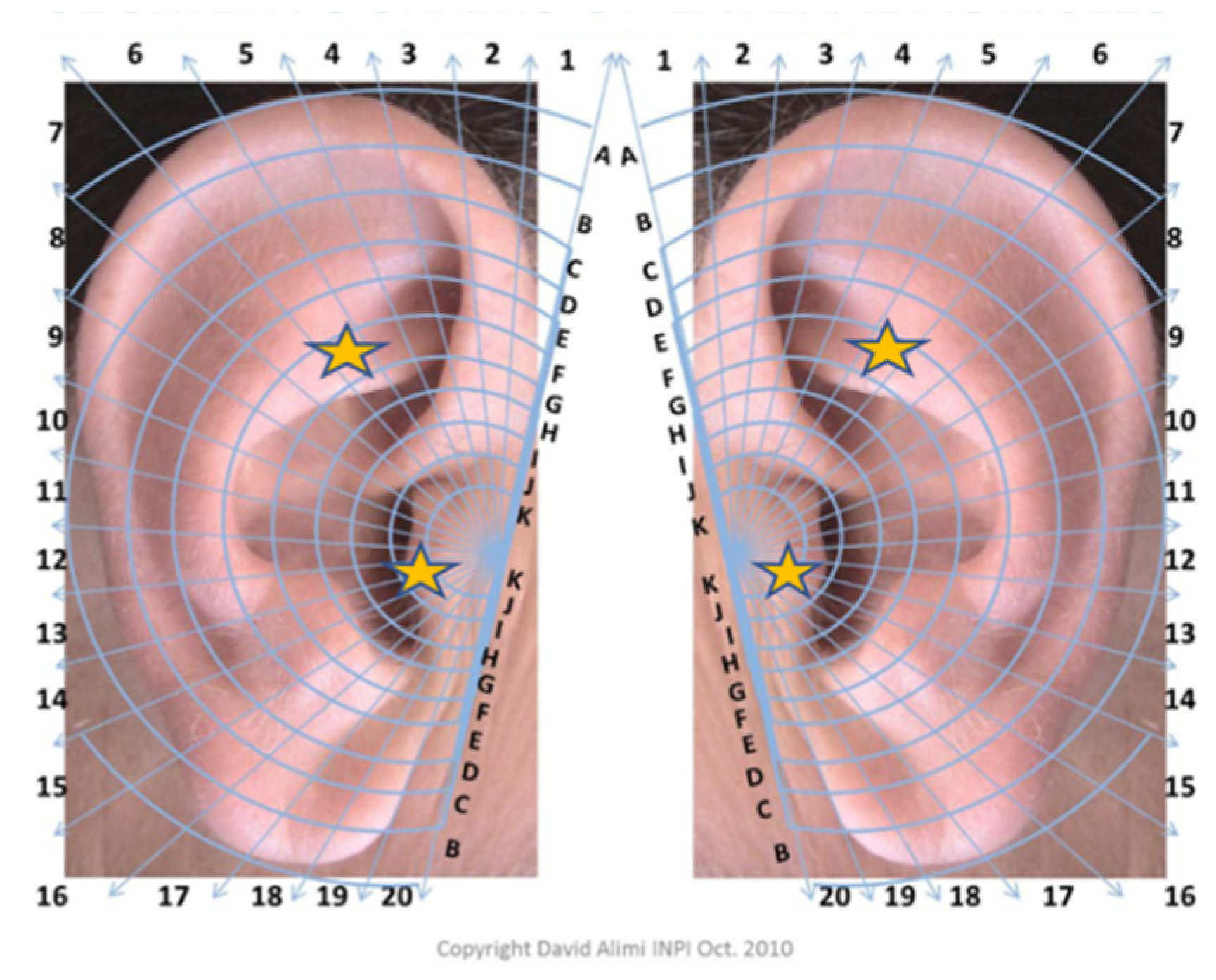
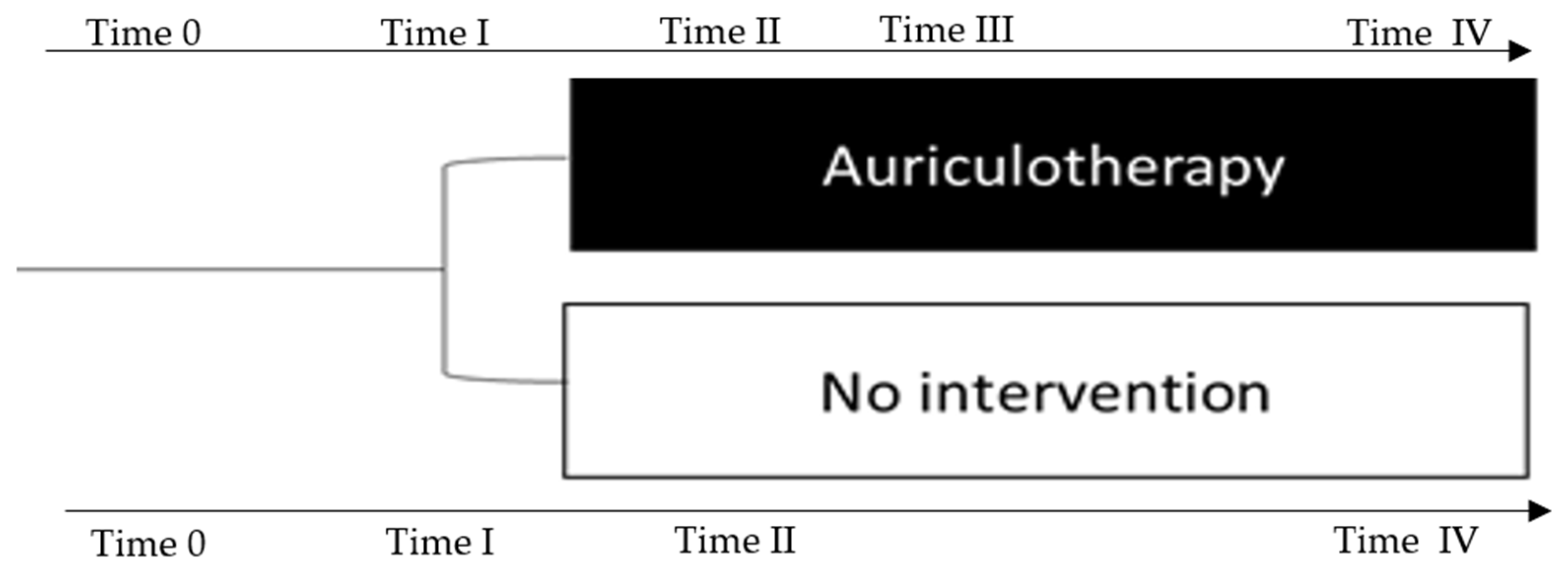
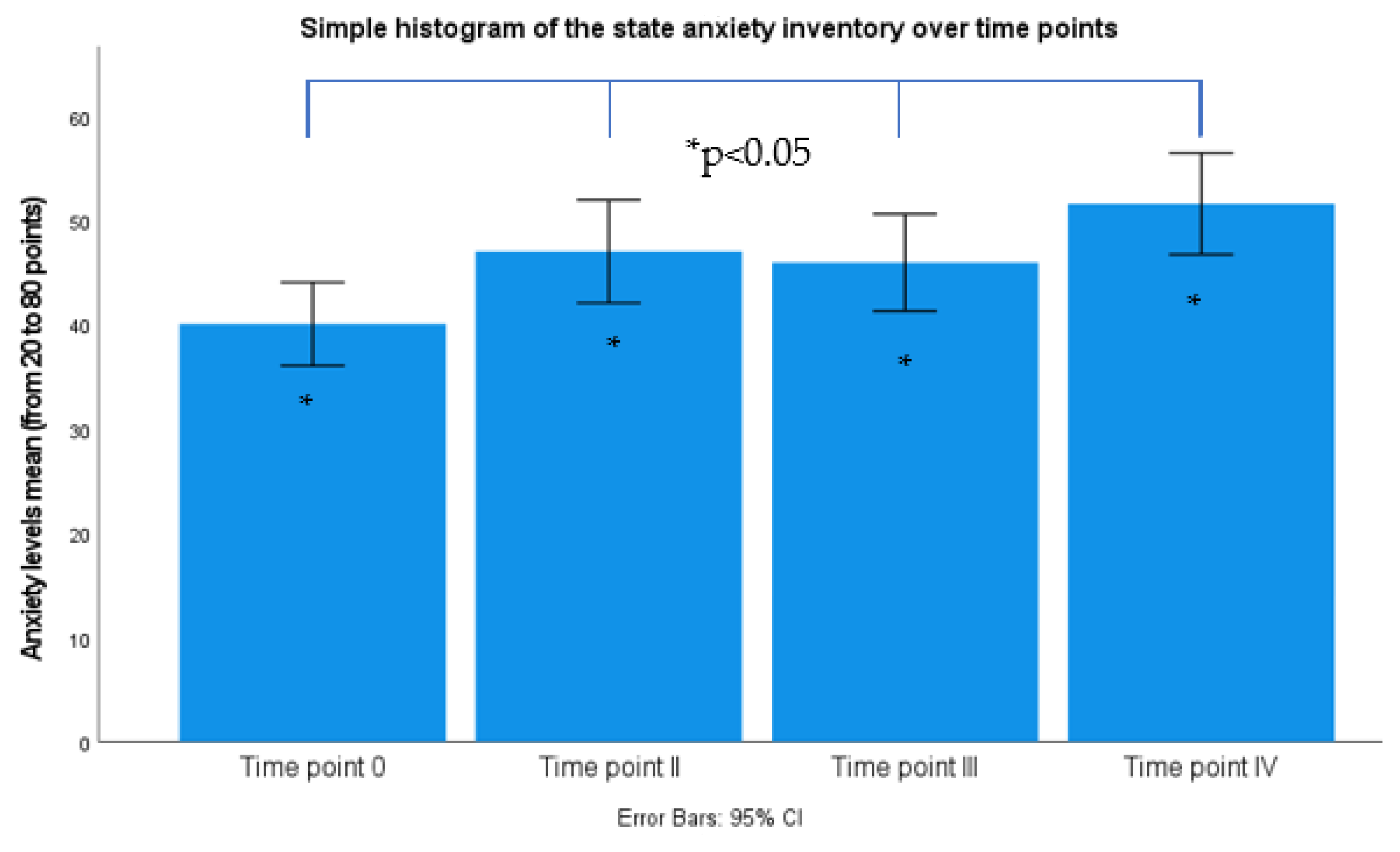
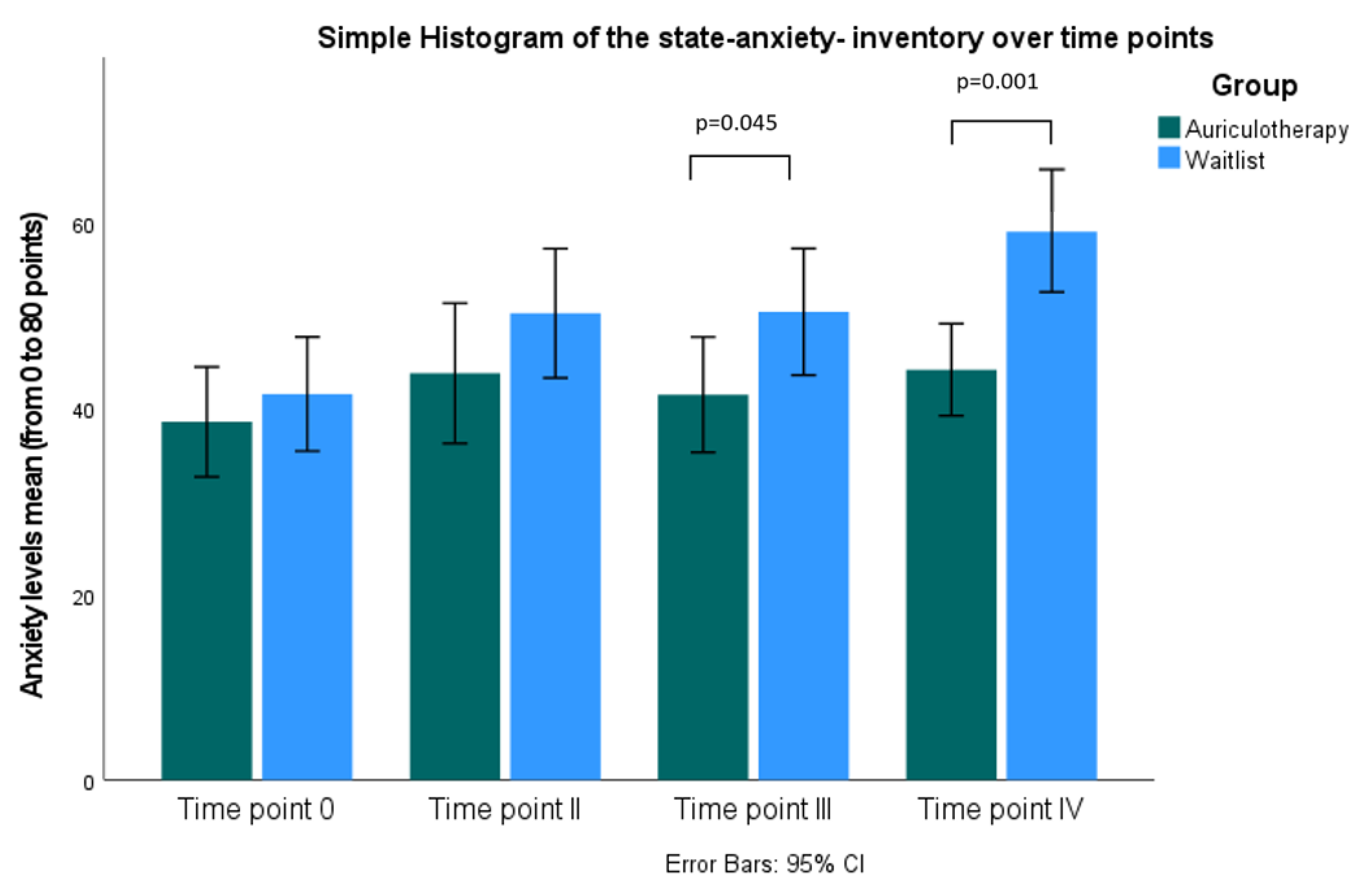
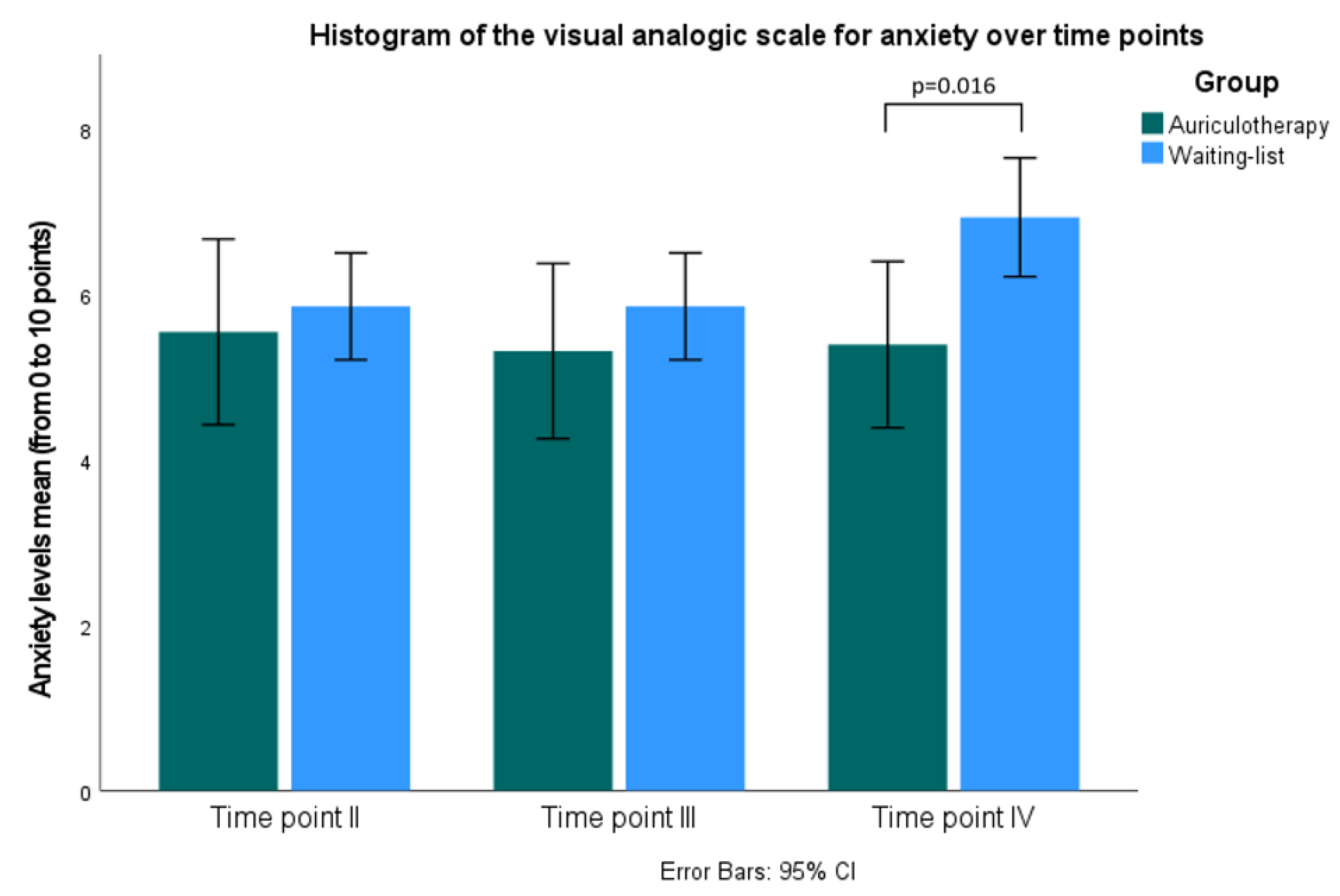
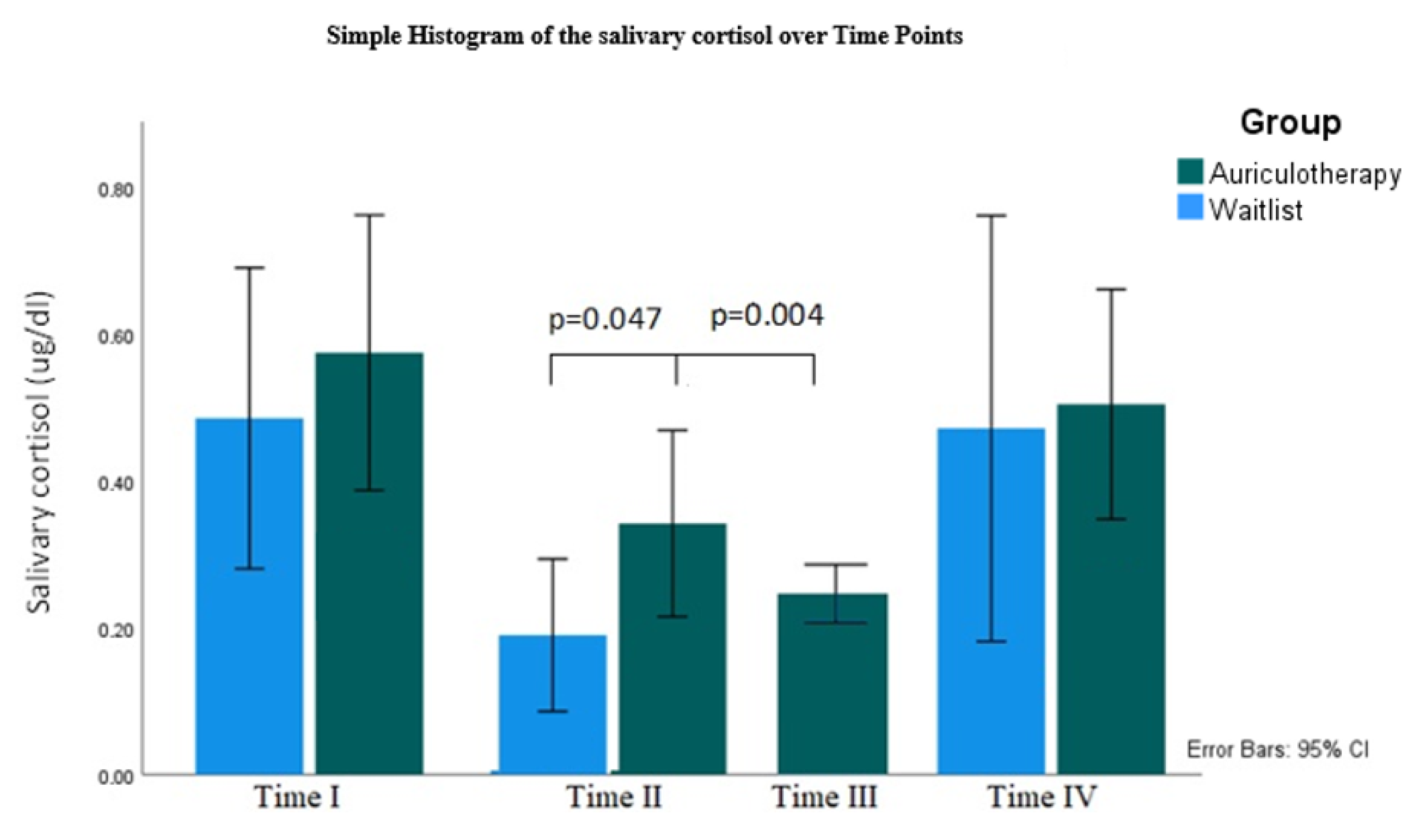

| Variables | Categories | Auriculotherapy | Waiting List | Significance |
|---|---|---|---|---|
| Alcohol Intake | Yes No | 0% 100% | 0% 100% | |
| Coffee | n M (SD) | 13 1.38 (1.26) | 13 1.6 (1.3) | 0.998 |
| Smoking Habits | Yes No | 66.7% 47.8% | 33.3% 52.2% | |
| Height (cm) | n M (SD) | 13 1.65 (0.08) | 13 1.67 (0.76) | 0.458 |
| Weight (kg) | n M (SD) | 11 68.18 (23.5) | 13 67.15 (12.73) | 0.892 |
| Gender | Female Male | 10 3 | 10 3 | |
| Age | n M (SD) | 12 20.08 (1.72) | 12 20.38 (1.89) | 0.683 |
| STAI-Trace | M (SD) n | 44.8 (7.9) 13 | 42.8 (8.4) 13 | 0.269 13 |
| Outcome | Time Points | Auriculotherapy Group M (SD) | Significance | Waiting List Group M (SD) |
|---|---|---|---|---|
| n | 13 | 13 | ||
| State Anxiety Inventory | I | 38.5 (9.7) | 0.451 | 41.5 (10.1) |
| II | 43.7 (12.4) | 0.183 | 50.23 (11.5) | |
| III | 41.4 (10.2) | 0.046 | 50.3 (11.2) | |
| IV | 44.1 (8.2) | 0.001 | 59.0 (10.7) | |
| Visual Analogue Scale | II | 5.5 (1.85) | 0.840 | 5.8 (1.1) |
| III | 5.3 (1.7) | 0.479 | 5.8 (1.1) | |
| IV | 5.3 (1.6) | 0.016 | 6.9 (1.1) |
| Time Points | |||||||||
|---|---|---|---|---|---|---|---|---|---|
| Outcome | Comparation | TP I | p | TPII | p | TP III | p | TP IV | p |
| Salivary cortisol from original data (ug/dL) | Auriculotherapy Group M (SD) | 0.51 (0.28) n = 12 | 0.374 | 0.34 (0.17) n = 10 | 0.047 | 0.25 (0.06) n = 11 | N.A | 0.49 + 0.21 n = 12 | 0.431 |
| Waiting list group M (SD) | 0.47 (0.20) n = 8 | 0.21 (0.12) n = 8 | N.A | 0.47 (0.31) n = 12 | |||||
| Outcome | Comparation | n | M (SD) | t | df | p |
|---|---|---|---|---|---|---|
| Salivary cortisol from original data (ug/dL) | Par 1: TP I—TP IV (auriculotherapy group) | 12 | 0.19 (0.31) | 0.215 | 11 | 0.417 |
| Par 1: TP I—TP IV (waiting list group) | 7 | 0.01 (0.18) | 0.197 | 6 | 0.425 | |
| Par 2: TP II—TP III (auriculotherapy group) | 9 | 0.10 (0.13) | 2.291 | 8 | 0.026 |
Publisher’s Note: MDPI stays neutral with regard to jurisdictional claims in published maps and institutional affiliations. |
© 2022 by the authors. Licensee MDPI, Basel, Switzerland. This article is an open access article distributed under the terms and conditions of the Creative Commons Attribution (CC BY) license (https://creativecommons.org/licenses/by/4.0/).
Share and Cite
Vieira, A.; Sousa, P.; Moura, A.; Lopes, L.; Silva, C.; Robinson, N.; Machado, J.; Moreira, A. The Effect of Auriculotherapy on Situational Anxiety Trigged by Examinations: A Randomized Pilot Trial. Healthcare 2022, 10, 1816. https://doi.org/10.3390/healthcare10101816
Vieira A, Sousa P, Moura A, Lopes L, Silva C, Robinson N, Machado J, Moreira A. The Effect of Auriculotherapy on Situational Anxiety Trigged by Examinations: A Randomized Pilot Trial. Healthcare. 2022; 10(10):1816. https://doi.org/10.3390/healthcare10101816
Chicago/Turabian StyleVieira, Andreia, Paula Sousa, Alexandra Moura, Lara Lopes, Cristiane Silva, Nicola Robinson, Jorge Machado, and António Moreira. 2022. "The Effect of Auriculotherapy on Situational Anxiety Trigged by Examinations: A Randomized Pilot Trial" Healthcare 10, no. 10: 1816. https://doi.org/10.3390/healthcare10101816
APA StyleVieira, A., Sousa, P., Moura, A., Lopes, L., Silva, C., Robinson, N., Machado, J., & Moreira, A. (2022). The Effect of Auriculotherapy on Situational Anxiety Trigged by Examinations: A Randomized Pilot Trial. Healthcare, 10(10), 1816. https://doi.org/10.3390/healthcare10101816







